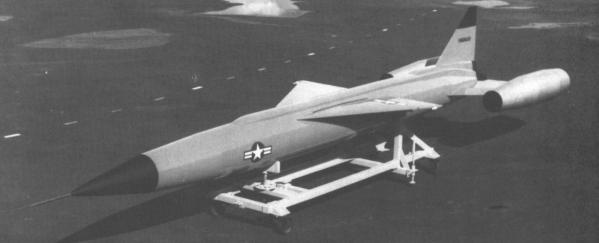Teledyne Ryan BQM-111 Firebrand
After the cancellation of the BQM-90 program in 1973, the Navy had to look for other target missiles to simulate attacking anti-ship missiles. In 1975, it was decided to convert some obsolete RIM-8 Talos missiles to MQM-8G Vandal targets as a short-term solution to simulate the terminal phase of a missile attack. In parallel, the ZBQM-111A program was defined to develop a completely new target vehicle which was to be able to replicate all phases of an anti-ship missile's mission profile. In May 1977, Teledyne Ryan was awarded the ZBQM-111A development contract for their Model 258 Firebrand target.
 |
| Photo: via Jane's |
| ZBQM-111A |
The Firebrand was designed as a parachute-recoverable ramjet-powered target suitable for ground and air launch. Solid-propellant rocket boosters propelled the BQM-111 to ramjet ignition speed of Mach 1.2. After an air launch from a DC-130, the Firebrand could cruise at Mach 2.0 at 12200 m (40000 ft) before diving to 90 m (300 ft) for the final run towards the "attacked" ship. The target was guided by a pre-programmed radio command guidance system with options for manual override. Any uncommanded deviation from the pre-planned mission profile would lead to immediate start of the recovery sequence to avoid endangering ships by an uncontrolled high-speed vehicle.
It was originally planned to build nine Firebrand test vehicles, and to begin flight tests in 1983. However, the ZBQM-111A program ran into funding difficulties. It also didn't help that the Firebrand design with its two ramjets and boosters came out as a heavy vehicle, possibly only marginally suitable for launch from the surface or from C-130 aircraft. The program was finally cancelled in January 1982. The Navy decided to continue the use of the MQM-8 Vandal instead, and to formulate a new requirement for a dedicated anti-ship missile target. The latter eventually resulted in the AQM-127 SLAT (Supersonic Low-Altitude Target) program.
Specifications
Note: Data given by several sources show slight variations. Figures given below may therefore be inaccurate!
Data for ZBQM-111A:
| Length | 10.4 m (34 ft) |
| Wingspan | 2.7 m (9 ft) |
| Diameter | 71 cm (28 in) |
| Weight (incl. boosters) | 2800 kg (6200 lb) |
| Speed | Mach 2.1 |
| Ceiling | 12200 m (40000 ft) |
| Range | ? |
| Propulsion | Booster: Thiokol solid-fueled rockets Sustainer: 2x Marquardt ramjet; 22 kN (5000 lb) each |
Main Sources
[1] William Wagner, William P. Sloan: "Fireflies and other UAVs", Midland Publishing, 1992
[2] Kenneth Munson: "World Unmanned Aircraft", Jane's, 1988
Back to Current Designations Of U.S. Unmanned Military Aerospace Vehicles
Back to Directory of U.S. Military Rockets and Missiles
Last Updated: 8 October 2002